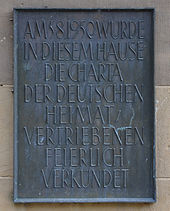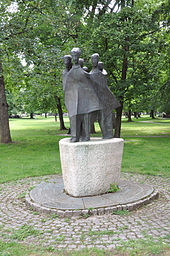Charter of the German expellees

The charter of the German expellees was signed by the spokesmen of the expellees' associations and East German country teams on August 5, 1950 and announced the following day in a mass rally in Stuttgart-Bad Cannstatt . It names the “duties and rights” of the refugees and displaced persons who had to leave the eastern German territories and other countries in eastern and south-eastern Europe between the Second World War and 1949 . These rights and obligations include, above all, the renunciation of revenge and retaliation for the expulsion , the creation of a united Europe and the participation in the reconstruction of Germany and Europe. In addition, a “ right to a home ” is postulated, which is a “God-given basic right of humanity”, and its realization is demanded.
history
After the allied coalition ban on expellees was relaxed in the western occupation zones at the end of the 1940s, they founded many associations of their own, which merged into regional associations and finally, in April 1949, into a central association of expelled Germans . At that time, refugees and displaced persons made up 16.5 percent of the population of the Federal Republic of Germany . Politically, these organizations had a special role in Germany. In order to lay down their self-image, after a few months they agreed on the formulation of this “charter”. Two years later, in November 1951, the Central Association, together with the Landsmannschaften of Sudeten Germans and Silesians, formed the Association of Expellees (BdV), which adopted the charter unchanged. To this day, the charter is the “basis of values” of the BdV.
One day before the signing of the Charter of German Expellees, the Czech National Committee of Czechs living in exile in London and the “Munich Working Group for the Safeguarding of Sudeten German Interests” presented a reconciliation document in the Wiesbaden Agreement , which simultaneously rejected collective guilt and, like the Charter, thoughts of revenge on both sides but demanded a punishment of those primarily responsible.
Demand for a right to the home
The charter postulates a “right to home” and justifies it on a theological basis. She explains: “We have lost our home. Homeless people are strangers on this earth. God put people in their homeland. Separating people from their homeland by force means killing them in spirit. We have suffered and experienced this fate. Therefore we feel called to demand that the right to a home is recognized and realized as one of the fundamental rights of humanity given by God. "
Proclaimed rights of displaced persons
In addition to the demand for a “right to home” and “as long as this right is not realized for us”, the charter contains further substantial demands of the displaced , namely equal citizenship before the law and in everyday life, the fair and meaningful distribution of the burdens of the War on the whole population, the demand for the integration of the professional groups of the displaced and their participation in the reconstruction of Europe . These requirements were met, for example through the Burdens Equalization Act of 1952 and the Federal Expellees Act of 1953.
External perception and debate
Federal German politicians have repeatedly emphasized the historical contribution of the expellee charter to reconciliation. On the occasion of the 50th anniversary of the charter, the then Federal Minister of the Interior Otto Schily ( SPD ) emphasized the “far-reaching significance” of the charter, “because it undermined radical domestic political aspirations and, in terms of foreign policy, a course of European unification, including our Central and Eastern European neighbors prepared. " Wolfgang Schäuble said on the occasion of the commemoration of the Landsmannschaft der Germans from Russia on the 65th anniversary of the expulsion of the Russian Germans on August 27, 2006 in Stuttgart:" [The] Charter was then and is still an impressive testimony to human greatness and Ability to learn. This charter is not determined by revanchism or despondency, but by belief in the future, Europeanism, Christian humanity. "
Micha Brumlik criticized the fact that in the sentence of the charter, "the peoples of the world should feel that they share responsibility for the fate of the displaced people as those most severely affected by the suffering of this time," it is asserted that the displaced persons were most severely affected, even before the murdered Jews, even before the persecuted in Poland and Russia and even before the German war orphans and widows. Even Ralph Giordano was the Charter iris the history of the expulsion and only mention those sold after 1945 Germans . Brumlik even found that in the charter “denial and repression of National Socialism are expressed in an ideal way”. That the charter in its opening sequence apparently generously "renounced" revenge and retaliation is an outrage. You can only do without what is rightfully yours. The charter postulates a fundamental right to revenge and retribution. Brumlik also emphasizes that around a third of the first signatories to the Charter were staunch National Socialists. These are mainly functionaries who had already been active in the so-called national struggle before the National Socialists came to power .
Brumlik points out that the Association of Displaced Persons is now presenting its concerns differently. He has since abandoned the Charter's thesis that German suffering is singular, thanks to Erika Steinbach . In the meantime, human rights , which the Charter does not mention, have also found their way into the self-image of the associations of expellees, for example in the statutes of the Center against Expulsions . The charter, on the other hand, still represents "a constitutional, völkisch-political founding document carried in the spirit of [...] self-pity and misunderstanding of history, in which nothing less than the intention to take the politics of the young Federal Republic hostage is certified." This would be credible But attitudes only changed after the charter, which is still in force today and which is the “constitution” of the associations of expellees, was formally repealed.
The “right to home” is a word created by French, Belgian and Greek international lawyers before the Second World War. After the Second World War, the right to the homeland was mainly promoted by the German international law experts Kurl Rabl, Rudolf Laun , Otto Kimminich and Dieter Blumenwitz , also by the Austrian international law specialist Felix Ermacora and the American international law specialist and historian Alfred de Zayas in connection with the " ethnic Purges ”in Yugoslavia.
In the political controversy of the Cold War , the proclamation of a right to the homeland by the organized displaced persons and the resulting claims for the return of the homeland areas of the displaced persons were interpreted by their political opponents as " revanchism ". After initially this was primarily the view of the states to which the territorial claims of the expellees associations referred, the agitation of the expellees associations against German Ostpolitik was increasingly understood in the political left of West Germany from the end of the 1960s . "Revanchism" became a political catchphrase in the West too.
The signatories of the charter
- Linus Kather ( Central Association of Expelled Germans , ZvD)
- Josef Walter (regional association [LV] of expellees in Hesse), former member of the Sudeten German party
- Hellmut Gossing (LV Lower Saxony in the ZvD)
- Karl Mocker (LvD Württemberg), former functionary of the Sudeten German Party
- Alexander Eschenbach (LvD, Stuttgart)
- Wilhelm Zeisberger (Association of New Citizens, Bavaria)
- Alfred Gille (LvD Schleswig-Holstein), former member of the NSDAP , area commissioner in the Reichskommissariat Ukraine
- Bernhard Geisler (course of the East Expellees North Rhine-Westphalia)
- Erwin Engelbrecht (LvD Bavaria)
- Anton Deichmann (LvD Rhineland-Palatinate)
- Roman Herlinger (Main Committee of Refugees and Expellees in Bavaria)
- Rudolf Lodgman von Auen ( Sudetendeutsche Landsmannschaft [LM]), co-founder of the German National Party in the 1st ČSR
- Erwin Tittes ( LM of the Transylvanian Saxony )
- Rudolf Wagner (LM of the resettlers from Bukovina ), SS-Obersturmbannführer
- Alfred Rojek (Berlin course for expellees)
- Walter von Keudell (LM Berlin - Brandenburg ), former politician ( DNVP , CNBLP , NSDAP and CDU )
- Konrad Winkler (community of interests of expellees in southern Baden)
- Axel de Vries ( German-Baltic LM)
- Franz Hamm (LM of the Germans from Yugoslavia ), block of the German National Socialist members of the Reichstag in Budapest, ethnic group leader of the Danube Swabians
- Erich Luft (LvD Bavaria)
- Karl Bartunek (LvD North Baden);
- Ottomar Schreiber ( LM East Prussia )
- Erik von Witzleben ( LM West Prussia ), SS-Sturmbannführer
- Walter Rinke ( LM Silesia )
- Anton Birkner ( Carpathian German LM Slovakia )
- Herbert von Bismarck ( Pomeranian LM )
- Waldemar Kraft ( LM Weichsel-Warthe ), Honorary Hauptsturmführer of the General SS , member of the NSDAP
- Gottlieb Leibbrandt (Arbeitsgemeinschaft der Ostumiedler, Russian Germans ), trainer for the NSDAP in Vienna; 1952 Fled to Canada because of threatened prosecution
- Fritz Kimme (LvD Bremen)
- Alfred Kautzor (Association of Expellees in Württemberg, Hohenzollern and Lindau)
literature
- Kurt Nelhiebel: 60 years charter of German expellees. Origin and reception of a document . In: Zeitschrift für Geschichtswwissenschaft, vol. 58, 2010, pp. 730–743.
See also
Web links
- Charter of the German expellees from August 5, 1950
- Matthias Stickler: Charter of the German expellees . In: Online encyclopedia on the culture and history of Germans in Eastern Europe
- 60 years of the Charter of Expellees and the Wiesbaden Agreement - Milestones in Christian reconciliation efforts - A contribution by church historian Prof. Dr. Rudolf Grulich
- Two milestones in German-Czech reconciliation - Bernd Posselt, chairman and spokesman for the Sudeten German Landsmannschaft, on the Wiesbaden Agreement and the charter of German expellees
Individual evidence
- ↑ Origin and meaning of the charter ( memento of January 21, 2012 in the Internet Archive ) ( Bund der Vertrieben ) The text of the charter can be found at: http://www.bund-der-vertrieben.de/charta-der-deutschen- homeland displaced persons / charter-in-german.html
- ↑ Helga Hirsch: Collective Memory in Transition , Federal Agency for Political Education, 2003
- ↑ Ceremony 50 years of the Federation of Expellees on October 22, 2007 in the Kronprinzenpalais Berlin Speech by President Erika Steinbach ( page no longer available , search in web archives ) Info: The link was automatically marked as defective. Please check the link according to the instructions and then remove this notice. (PDF; 83 kB)
- ^ Foundation House of the History of the Federal Republic of Germany: Charter of German expellees from August 5, 1950
- ↑ Alexander Loesch: Displaced persons: The organization's charter is 50 years old. Der Tagesspiegel, August 17, 2000 .
- ↑ Speech by Federal Minister Dr. Wolfgang Schäuble on the occasion of the commemoration of the Landsmannschaft der Germans from Russia on the 65th anniversary of the expulsion of the Russian Germans on August 27, 2006 in Stuttgart ( Memento from April 30, 2009 in the Internet Archive )
- ↑ Micha Brumlik: Who sows a storm. The expulsion of the Germans. Berlin 2000 ISBN 3-351-02580-7 p. 98
- ↑ Ralph Giordano: Ostpreußen ade , Munich, 5th edition 1999 ISBN 3-423-30566-5 p. 105 ff.
- ↑ Micha Brumlik: Who sows a storm. The expulsion of the Germans. Berlin 2000, p. 92
- ↑ Micha Brumlik: Who sows a storm. The expulsion of the Germans. Berlin 2000, p. 95
- ↑ Micha Brumlik: Who sows a storm. The expulsion of the Germans. Berlin 2000 pp. 100-105
- ↑ Micha Brumlik: Who sows a storm. The expulsion of the Germans. Berlin 2000, pp. 99, 100, 108
- ↑ Vita . In Canada in the mid-1970s he acted as a German-Canadian historian.


